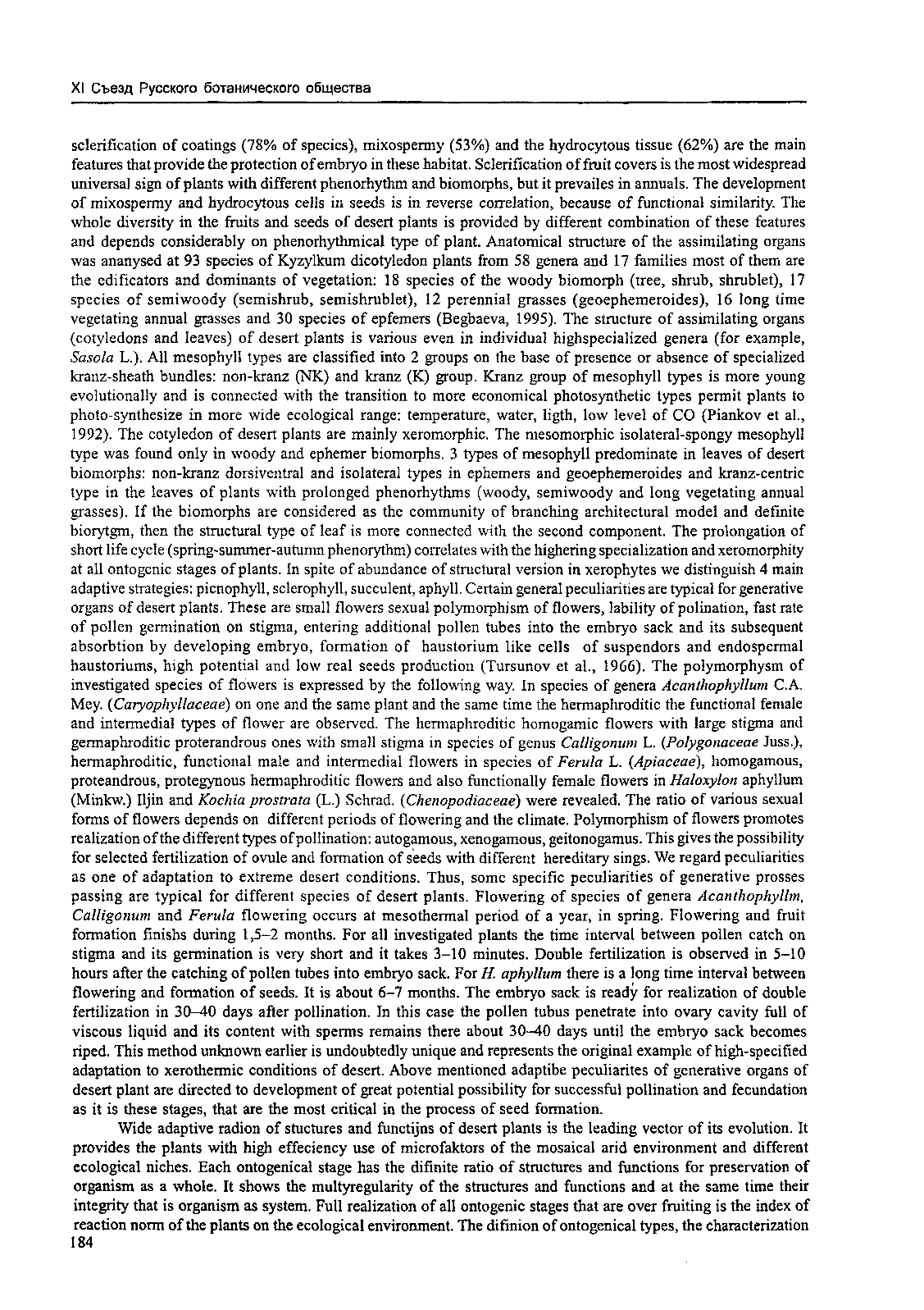

XI Съезд Русского ботанического общества
sclerification o f coatings (78% of species), mixospermy (53%) and the hydrocytous tissue (62%) are the main
features that provide the protection o f embryo in these habitat. Sclerification o f fruit covers is the most widespread
universal sign o f plants with different phenorhythm and biomorphs, but it prevailes in annuals. The development
o f mixospermy and hydrocytous cells in seeds is in reverse correlation, because of functional similarity. The
whole diversity in the fruits and seeds o f desert plants is provided by different combination of these features
and depends considerably on phenorhythmical type of plant. Anatomical structure o f the assimilating organs
was ananysed at 93 species o f Kyzylkum dicotyledon plants from 58 genera and 17 families most of them are
the edificators and dominants o f vegetation: 18 species o f the woody biomorph (tree, shrub, shrublet), 17
species o f semiwoody (semishrub, semishrub let), 12 perennial grasses (geoephemeroides), 16 long time
vegetating annual grasses and 30 species o f epfemers (Begbaeva, 1995). The structure o f assimilating organs
(cotyledons and leaves) o f desert plants is various even in individual highspecialized genera (for example,
Sasola
L.). All mesophyll types are classified into 2 groups on the base of presence or absence of specialized
kranz-sheath bundles: non-kranz (NK) and kranz (K) group. Kranz group of mesophyll types is more young
evolutionally and is connected with the transition to more economical photosynthetic types permit plants to
photo-synthesize in more wide ecological range: temperature, water, ligth, low level of CO (Piankov et al.,
1992). The cotyledon of desert plants are mainly xeromorphic. The mesomorphic isolateral-spongy mesophyll
type was found only in woody and ephemer biomorphs. 3 types o f mesophyll predominate in leaves of desert
biomorphs: non-kranz dorsiventral and isolateral types in ephemers and geoephemeroides and kranz-centric
type in the leaves of plants with prolonged phenorhythms (woody, semiwoody and long vegetating annual
grasses). If the biomorphs are considered as the community of branching architectural model and definite
biorytgm, then the structural type of leaf is more connected with the second component. The prolongation of
short life cycle (spring-summer-autumn phenorythm) correlates with the highering specialization and xeromorphity
at all ontogenic stages of plants. In spite of abundance of structural version in xerophytes we distinguish 4 main
adaptive strategies: picnophyll, sclerophyll, succulent, aphyll. Certain general peculiarities are typical for generative
organs of desert plants. These are small flowers sexual polymorphism of flowers, lability of polination, fast rate
o f pollen germination on stigma, entering additional pollen tubes into the embryo sack and its subsequent
absorbtion by developing embryo, formation of haustorium like cells o f suspendors and endospermal
haustoriums, high potential and low real seeds production (Tursunov et al., 1966). The polymorphysm of
investigated species of flowers is expressed by the following way. In species of genera
Acanthophyllum
C.A.
Mey. (
Caryophyllaceae
) on one and the same plant and the same time the hermaphroditic the functional female
and intermedial types of flower are observed. The hermaphroditic homogamic flowers with large stigma and
germaphroditic proterandrous ones with small stigma in species of genus
Calligonum
L.
(Polygonaceae
Juss.),
hermaphroditic, functional male and intermedial flowers in species of
Ferula
L. (
Apiaceae
), homogamous,
proteandrous, protegynous hermaphroditic flowers and also functionally female flowers in
Haloxylon
aphyllum
(Minkw.) Iljin and
Kochia prostrata
(L.) Schrad. (
Chenopodiaceae
) were revealed. The ratio o f various sexual
forms of flowers depends on different periods of flowering and the climate. Polymorphism o f flowers promotes
realization of the different types of pollination: autogamous, xenogamous, geitonogamus. This gives the possibility
for selected fertilization of ovule and formation of seeds with different hereditary sings. We regard peculiarities
as one of adaptation to extreme desert conditions. Thus, some specific peculiarities of generative prosses
passing are typical for different species of desert plants. Flowering of species o f genera
Acanthophyllm
,
Calligonum
and
Ferula
flowering occurs at mesothermal period o f a year, in spring. Flowering and fruit
formation finishs during 1,5-2 months. For all investigated plants the time interval between pollen catch on
stigma and its germination is very short and it takes 3-10 minutes. Double fertilization is observed in 5-10
hours after the catching of pollen tubes into embryo sack. For
H. aphyllum
there is a long time interval between
flowering and formation of seeds. It is about 6-7 months. The embryo sack is ready for realization of double
fertilization in 30-40 days after pollination. In this case the pollen tubus penetrate into ovary cavity full of
viscous liquid and its content with sperms remains there about 30-40 days until the embryo sack becomes
riped. This method unknown earlier is undoubtedly unique and represents the original example of high-specified
adaptation to xerothermic conditions of desert. Above mentioned adaptibe peculiarites of generative organs of
desert plant are directed to development of great potential possibility for successful pollination and fecundation
as it is these stages, that are the most critical in the process of seed formation.
Wide adaptive radion of stuctures and functijns o f desert plants is the leading vector o f its evolution. It
provides the plants with high effeciency use of microfaktors of the mosaical arid environment and different
ecological niches. Each ontogenical stage has the difinite ratio of structures and functions for preservation of
organism as a whole. It shows the multyregularity of the structures and functions and at the same time their
integrity that is organism as system. Full realization of all ontogenic stages that are over fruiting is the index of
reaction norm o f the plants on the ecological environment. The difinion of ontogenical types, the characterization
184
Электронная Научная СельскоХозяйственная Библиотека









